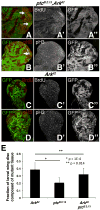Regulation of Yorkie activity in Drosophila imaginal discs by the Hedgehog receptor gene patched
- PMID: 22705500
- PMCID: PMC3668547
- DOI: 10.1016/j.mod.2012.05.007
Regulation of Yorkie activity in Drosophila imaginal discs by the Hedgehog receptor gene patched
Abstract
The Hedgehog (Hh) pathway was first defined by its role in segment polarity in the Drosophila melanogaster embryonic epidermis and has since been linked to many aspects of vertebrate development and disease. In humans, mutation of the Patched1 (PTCH1) gene, which encodes an inhibitor of Hh signaling, leads to tumors of the skin and pediatric brain. Despite the high level of conservation between the vertebrate and invertebrate Hh pathways, studies in Drosophila have yet to find direct evidence that ptc limits organ size. Here we report identification of Drosophila ptc in a screen for mutations that require a synergistic apoptotic block in order to drive overgrowth. Developing imaginal discs containing clones of ptc mutant cells immortalized by the concurrent loss of the Apaf-1-related killer (Ark) gene are overgrown due, in large part, to the overgrowth of wild type portions of these discs. This phenotype correlates with overexpression of the morphogen Dpp in ptc,Ark double-mutant cells, leading to elevated phosphorylation of the Dpp pathway effector Mad (p-Mad) in cells surrounding ptc,Ark mutant clones. p-Mad functions with the Hippo pathway oncoprotein Yorkie (Yki) to induce expression of the pro-growth/anti-apoptotic microRNA bantam. Accordingly, Yki activity is elevated among wild type cells surrounding ptc,Ark clones and alleles of bantam and yki dominantly suppress the enlarged-disc phenotype produced by loss of ptc. These data suggest that ptc can regulate Yki in a non-cell autonomous manner and reveal an intercellular link between the Hh and Hippo pathways that may contribute to growth-regulatory properties of the Hh pathway in development and disease.
Copyright © 2012. Published by Elsevier Ireland Ltd.
Figures





References
-
- Akdemir F, Farkas R, Chen P, Juhasz G, Medved'ova L, Sass M, Wang L, Wang X, Chittaranjan S, Gorski SM, Rodriguez A, Abrams JM. Autophagy occurs upstream or parallel to the apoptosome during histolytic cell death. Development. 2006;133:1457–1465. - PubMed
-
- Asano M, Nevins JR, Wharton RP. Ectopic E2F expression induces S phase and apoptosis in Drosophila imaginal discs. Genes Dev. 1996;10:1422–1432. - PubMed
-
- Bale AE. Hedgehog signaling and human disease. Annu Rev Genomics Hum Genet. 2002;3:47–65. - PubMed
-
- Boedigheimer M, Bryant P, Laughon A. Expanded, a negative regulator of cell proliferation in Drosophila, shows homology to the NF2 tumor suppressor. Mech Dev. 1993;44:83–84. - PubMed
Publication types
MeSH terms
Substances
Grants and funding
LinkOut - more resources
Full Text Sources
Molecular Biology Databases
Research Materials

